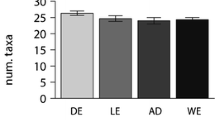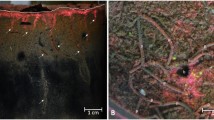Abstract
The cosmopolitan benthic foraminiferan, Ammonia beccarii, is a fervent microfloral predator which often forms densely-populated 2–4 cm2 aggregates in the field. Sediments within aggregate patches become extensively pelletized, mucus bound and depleted in microfloral food. On a West German Wattenmeer mudflat, copepodite and naupliar densities of a predominant harpacticoid copepod, Amphiascoides limicola, were significantly depressed in sediments containing>100 A. beccarii·3 cm-2 suggesting a possible foraminiferal: copepod amensalism. Therefore, I cultured A. beccarii and A. limicola separately in sediment microcosms and then tested if A. limicola's seemingly negative reaction to sediments containing A. beccarii occurs under controlled conditions, how various life stages of A. limicola are affected, and what the repulsive mechanisms of A. beccarii may be. In natural field sediments seeded with a latin-square dispersion of sterile sediment patches containing 0 or 100 A. beccarii, mean A. limicola naupliar and copepodite densities were 2 to 6 times lower in Ammonia-rich patches than Ammonia-poor patches (i.e. patches containing <100 A. beccarii·3 cm-2). Choice experiments directly testing potential A. beccarii inhibitory mechanisms were conducted with A. limicola copepodites: Cubic microcosms containing a latin-square patch dispersion of (1) sterile sediments (SS) seeded with 100 A. beccarii (low microflora), (2) SS bound with sterile mucus (0.0001%) (low microflora), (3) SS seeded with pelletized sediments (high microflora), and (4) SS seeded with mucus and pellets (high microflora), showed that copepodites colonized 1≪2 & 3, but 1 & 4 were not significantly different. Mucus addition by itself, in the absence of pelletization and microflora, strongly facilitated colonization—as did addition of microfloral-rich pelletized sediments. Pelletization and mucousbinding combined, but with low microflora, were least attractive to A. limicola. Pelletization and mucous-binding combined, but with high microflora, were more attractive to A. limicola than its complement, but not significantly so. Thus A. beccarii's inhibition of A. limicola is probably not caused by sediment pelletization and simple mucous exudates but by local microfloral depletion within aggregate foraminiferal patches.
Similar content being viewed by others
References
Bartlett MS (1937) Some examples of statistical methods of research in agriculture and applied biology. J Royal Stat Soc (suppl) 4:137–147
Basov JA, Khusid TA (1983) On the biomass of benthonic Foraminifera in the Sea of Okhotsk sediments. Okeanologiya 23 (4):648–655
Bell SS, Watzin MC, Coull BC (1978) Biogenic structure and its effect on the spatial heterogeneity of meiofauna in a salt marsh. J Exp Mar Biol Ecol 35:99–107
Bernstein BB, Hessler RR, Smith R, Jumars PA (1978) Spatial dispersion of benthic Foraminifera in the abyssal central North Pacific. Limnol Oceanogr 23:401–416
Billheimer LE, Coull BC (1988) Bioturbation and recolonization of meiobenthos in juvenile Spot (Pisces) feeding pits. Est Coast Shelf Sci 27:335–340
Boltovsky E, Lena H (1969) Microdistribution des foraminiferes benthoniques vivants. Rev Micropaleo 12:177–185
Bradshaw JS (1957) Laboratory experiments on the rate of growth of the foraminifer, “Streblus beccarii (Linne') var. tepida (Cushman)”. J Paleontology 31:1138–1147
Brooks AL (1967) Standing crop, vertical distribution, and morphometrics of Ammonia beccarii. Limnol Oceanogr 12:667–684
Buss LW (1976) Better living through chemistry: the relationship between allelopathy and competitive networks. In: Harrison FW, Cowden RR (eds) Aspects of sponge biology. Academic Press, New York, pp 315–328
Buzas MA (1968) On the spatial distribution of Foraminifera. Contr Cushman Found Foram Res 19:1–11
Chandler GT (1986) High density culture of meiobenthic harpacticoid copepods within a muddy sediment substrate. Can J Fish Aq Sci 43:53–59
Chandler GT, Fleeger JW (1983) Meiofaunal colonization of azoic estuarine sediment in Louisiana: Mechanisms of dispersal. J Exp Mar Biol Ecol 69:175–188
Chandler GT, Fleeger JW (1984) Tube-building by a marine meiobenthic harpacticoid copepod. Mar Biol 82:15–19
Chandler GT, Fleeger JW (1987) Facilitative and inhibitory interactions among estuarine meiobenthic harpacticoid copepods. Ecology 68 (6):1906–1919
Connell JH (1961) The influence of interspecific competition and other factors on natural populations of the barnacle Balanus balanoides. Ecology 42:710–723
Coull BC, Bell SS (1979) Perspectives of marine meiofaunal ecology. In: Livingston RJ (ed) Ecological processes in coastal and marine ecosystems, Plenum Press, New York, pp 189–216
Decho AW, Castenholz RW (1986) Spatial patterns and feeding of meiobenthic harpacticoid copepods in relation to resident microbial flora. Hydrobiologia 131:87–96
Decho AW, Fleeger JW (1988) Ontogenetic feeding shifts in the meiobenthic harpacticoid copepod Nitocra lacustris. Mar Biol 97:191–197
Ellison RL (1972) Ammobaculites, foraminiferal proprietor of Chesapeake Bay estuaries. Geol Soc Am Mem 133:247–262
Ellison RL (1984) Foraminifera and meiofauna on an intertidal mudflat, Cornwall England: Populations, respiration and secondary production, and energy budget. Hydrobiologia 109:131–147
Findlay SEG (1981) Small-scale spatial distribution of meiofauna on a mud- and sandflat. Est Coast Shelf Sci 12:471–484
Gallagher ED, Jumars PA, Trueblood DD (1983) Facilitation of soft-bottom benthic succession by tube builders. Ecology 64:1200–1216
Giere O (1973) Oxygen in the marine hydropsammal and the vertical microdistribution of oligochaetes. Mar Biol 21:180–189
Hofker J (1977) The Foraminifera of Dutch tidal flats and salt marshes. Neth J Sea Res 11:223–296
Jackson JBC (1977) Competition on marine hard substrata: the adaptive significance of solitary and colonial strategies. Am Nat 111:743–767
Kontrovitz M, Snijder SW, Brown JR (1978) A flume study of the movement of Foraminifera tests. Palaeogeogr Palaeoclim Palaeoecol 23:141–150
Lang JC (1971) Interspecific aggression by scleractinian corals. I. The rediscovery of Scolymia cubensis (Milne-Edwards and Haime). Bull Mar Sci 21:952–959
Lee JJ (1974) Towards understanding the niche of Foraminifera. In: Hedley RH, Adams G (eds) Foraminifera, vol I, Academic Press, NY, pp 207–260
Lee JJ, Stone RJ, McEnergy M, Muller WA (1972) Physiological perspectives on the ecology of Foraminifera in a Long Island salt marsh. Proc Shellfish Culture Conference, Reg Mar Res Council Nassau-Suffolk Reg Plan Bd, pp 11–32
Lee JJ, Tietjen JH, Mastropaolo C, Rubin H (1977) Food quality and the heterogeneous spatial distribution of meiofauna. Helgoländer Wiss Meeresunters 30:272–282
LeFurgey A, St. Jean J (1976) Foraminifera in brackish water ponds designed for waste control and aquaculture studies in North Carolina. J Foram Res 6:274–294
Matera NJ, Lee JJ (1972) Environmental factors affecting the standing crop of Foraminifera in sublittoral and psammolittoral communities of a Long Island salt marsh. Mar Biol 14:89–103
McCall PL (1977) Community patterns and adaptive strategies of the infaunal benthos of Long Island Sound. J Mar Res 35:221–226
Muller WA (1975) Competition for food and other niche-related studies of three species of salt-marsh Foraminifera. Mar Biol 31:339–351
Neter J, Wasserman W (1974) Applied linear statistical models, RD Irwin, Inc, Homewood, Illinois
Olsson I, Eriksson B (1974) Horizontal distribution of meiofauna within a small area, with special reference to Foraminifera. Zoom 2:67–84
Palmer MA, Gust G (1985) Dispersal of meiofauna in a turbulent tidal creek. J Mar Res 43:179–210
Parker FL, Phleger FB, Peirson JF (1953) Ecology of Foraminifera from San Antonio Bay and environments, southern Texas. Cushman Found Foram Res Spec Publ 2:1–75
Rhoads DC, Young DK (1970) The influence of deposit-feeding organisms on sediment stability and community trophic structure. J Mar Res 28:150–178
Roughgarden J (1978) Influence of competition on patchiness in a random environment. Theor Pop Biol 14:185–203
Roughgarden J (1983) Competition and theory in community ecology. Am Nat 122 (5):583–601
Scheibel W (1976) Quantitative Untersuchungen am Meiobenthos eines Profils unterschiedlicher Sedimente in der westlichen Ostsee. Helgoländer Wiss Meeresunters 28:31–42
Sherman KM, Coull BC (1980) The response of meiofauna to sediment disturbance. J Exp Mar Biol Ecol 46:59–71
Watzin MC (1983) The effects of meiofauna on settling macrofauna: Meiofauna may structure macrofaunal communities. Oecologia 59:163–166
Watzin MC (1986) Larval settlement into marine soft sediment systems: interactions with the meiofauna. J Exp Biol Ecol 98:65–113
Wefer G, Lutze GF (1976) Benthic Foraminifera biomass production in the Western Baltic. Kieler Meeresforschungen [S] 3:76–81
Woodin SA (1976) Adult-larval interactions in dense infaunal assemblages: patterns of abundance. J Mar Res 34:25–41
Author information
Authors and Affiliations
Additional information
Contribution No 774 of the Belle W. Baruch Institute for Marine Biology and Coastal Research
Rights and permissions
About this article
Cite this article
Chandler, G.T. Foraminifera may structure meiobenthic communities. Oecologia 81, 354–360 (1989). https://doi.org/10.1007/BF00377083
Received:
Accepted:
Issue Date:
DOI: https://doi.org/10.1007/BF00377083




